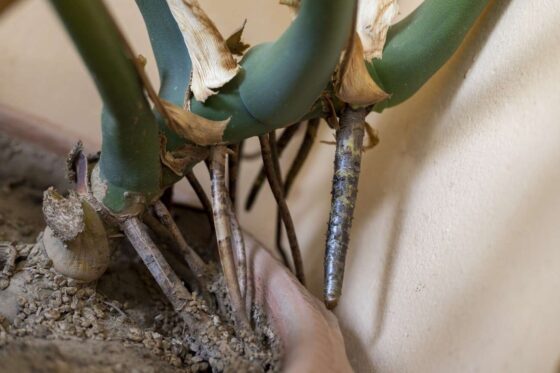Did you know that Monstera plants have fascinating aerial roots that hang down from their stems? These unique roots serve an important purpose in the plant’s growth and survival. If you’ve ever wondered about these intriguing appendages and how to care for them, you’re in the right place.
In this article, we’ll unravel the mystery behind Monstera aerial roots and provide you with all the information you need to support your plant’s health and vitality. So, let’s dive right in and explore the captivating world of Monstera aerial roots!
Monstera Aerial Roots: Exploring the Fascinating Adaptations of a Houseplant
Monstera plants, with their large, lush leaves and unique fenestrations, have become a popular choice for indoor greenery enthusiasts. Beyond their striking appearance, monstera plants possess an intriguing feature that sets them apart from many other houseplants – aerial roots.
These roots, which grow above the ground, serve various purposes and add to the overall charm of the monstera plant. In this article, we will delve into the world of monstera aerial roots, exploring their functions, care requirements, and how they contribute to the plant’s growth and overall health.
What Are Aerial Roots?
Aerial roots, as the name suggests, are roots that grow above the ground. While most plants develop roots that remain hidden beneath the soil, monstera plants have evolved to develop these specialized roots to adapt to their environment. Aerial roots can be found growing out of the node where a leaf connects to the stem.
Unlike regular roots that primarily absorb water and nutrients from the soil, aerial roots serve multiple functions. They provide additional support to the plant, allow for the absorption of moisture and nutrients from the air, and help the monstera plant climb and anchor itself in its natural habitat. These adaptations have made monstera plants highly successful in their native rainforest environments.
The Functions of Monstera Aerial Roots
Monstera aerial roots play several vital roles in the overall health and growth of the plant. Let’s explore these functions in detail:
- Support and Anchorage: One of the primary functions of aerial roots is to provide support and anchorage to the plant. In their natural rainforest habitat, monstera plants can grow as climbers, using their aerial roots to latch onto trees and other structures. The roots wrap around and grip onto surfaces, providing stability and preventing the plant from toppling over.
- Nutrient Absorption: Aerial roots have the remarkable ability to absorb moisture and nutrients from the air. They possess tiny structures called velamen, which act as sponges, absorbing humidity and moisture present in the surrounding environment. This adaptation allows monstera plants to thrive even when the soil conditions are less than ideal.
- Supplemental Root System: While monstera plants also have traditional underground roots, the aerial roots act as a supplemental root system. They expand the plant’s overall root network, helping it access more resources and increasing its capacity to absorb water and nutrients.
- Exploration and Attachment: Aerial roots serve as exploratory appendages for the plant, reaching out and searching for suitable surfaces to attach to. They are highly sensitive to touch and can detect the presence of nearby objects. Once they make contact with a surface, the roots initiate a coiling mechanism, firmly attaching the plant to the structure.
Read More: About Can Monstera Thrive In Low Light?
Caring for Monstera Aerial Roots
Proper care is essential to ensure the health and vitality of monstera aerial roots. By providing the right conditions, you can encourage their growth and support the overall well-being of your monstera plant. Here are some tips for caring for monstera aerial roots:
1. Provide Adequate Humidity
Monstera plants, including their aerial roots, thrive in environments with high humidity. Mimic the moist conditions of their rainforest habitat by using the following techniques:
- Place a tray filled with water near the plant to increase humidity through evaporation.
- Use a humidifier to maintain an optimal level of humidity.
- Mist the aerial roots and foliage regularly.
2. Offer Sufficient Light
Monstera plants, like most houseplants, require bright, indirect light to thrive. Place your monstera near a north- or east-facing window, ensuring it receives bright, filtered light throughout the day. Avoid exposing the plant to direct sunlight, as it can scorch the leaves and affect the health of the aerial roots.
3. Support Climbing
If you wish to encourage your monstera plant to climb and utilize its aerial roots, provide a suitable support structure. This can be a moss pole, trellis, or wooden stake placed near the plant. Gently guide the aerial roots towards the support, allowing them to cling and secure the plant as it grows.
4. Watering and Feeding
Watering and feeding your monstera plant correctly will ensure the aerial roots receive the necessary nutrients for healthy growth. Follow these guidelines:
- Allow the top inch of soil to dry out before watering your monstera.
- Water thoroughly until water drains out of the bottom of the pot.
- Use a balanced liquid fertilizer during the growing season to provide essential nutrients.
5. Avoid Overwatering
While monstera plants appreciate regular watering, overwatering can lead to root rot and other issues. Always check the moisture level of the soil before watering and ensure proper drainage to prevent water from accumulating around the roots.
6. Pruning and Maintenance
Regular pruning helps maintain the health and appearance of both the foliage and the aerial roots of your monstera. Remove any yellowing or damaged leaves and trim any excessively long or unruly aerial roots. Pruning also helps promote new growth and encourages the plant to allocate energy to healthy foliage and root development.
Monstera aerial roots are not only visually captivating but also serve a vital purpose in the plant’s survival. Their ability to provide support, absorb nutrients, and explore their surroundings makes them fascinating adaptations.
By understanding and caring for these aerial roots, you can promote the overall health and well-being of your monstera plant. Remember to provide adequate humidity, offer sufficient light, support climbing, water and feed correctly, and engage in regular pruning. With these measures in place, you can enjoy the beauty and vitality of your monstera plant and its remarkable aerial roots for years to come.
Read More: About How to Make Monstera Grow Faster
Frequently Asked Questions (FAQs)
Monstera aerial roots are roots that grow above the ground or attach themselves to surfaces such as trees or rocks. They are unique to the monstera plant and serve various purposes.
Monstera aerial roots have multiple functions. They help the plant attach itself to surfaces for support, gather water and nutrients from the air, and provide stability to the plant.
Taking care of monstera aerial roots is relatively simple. Ensure that they have access to moisture by misting them regularly or providing a humid environment. Avoid cutting or damaging the roots to maintain the plant’s overall health.
It is generally recommended not to prune monstera aerial roots unless absolutely necessary. These roots play a vital role in the plant’s overall health and cutting them can cause stress to the plant.
If your monstera aerial roots are turning brown, it could be an indication of underwatering, excessive sunlight exposure, or lack of humidity. Ensure that you are providing adequate water, placing the plant in an appropriate light environment, and maintaining humidity levels to prevent browning.
Yes, monstera aerial roots can be propagated. If you have a healthy, mature monstera plant with aerial roots, you can carefully cut a section of the stem with an aerial root and propagate it in water or a well-draining soil mix.
Monstera aerial roots are generally not harmful to other plants. However, if they start encroaching on other plants, they can compete for resources such as light and nutrients. Regular monitoring and pruning can help control their growth.
If your monstera aerial roots become excessively long, you can gently guide them towards a support structure or trim them back to a manageable length. Avoid cutting them entirely, as they are essential for the plant’s health and stability.
Final Thoughts
Monstera aerial roots are fascinating and unique features of this popular houseplant. These roots, which hang down from the stems, serve a dual purpose. Not only do they anchor the plant and provide support, but they can also absorb moisture and nutrients from the air. Monstera aerial roots are not to be confused with regular roots that grow in the soil.
These aerial roots are an adaptation that allows the plant to thrive in its native tropical rainforest habitat. So, the next time you admire your monstera, take a moment to appreciate its remarkable aerial roots and their important role in its growth and survival.
Auto Amazon Links: No products found.
Perfect Plants Christmas Tree Saver 8oz. | Easy Use Xmas Tree Preserver Food | Have Healthy Green Christmas Trees All Holiday Season
$7.99 (as of December 23, 2025 06:28 GMT +00:00 - More info- Product prices and availability are accurate as of the date/time indicated and are subject to change. Any price and availability information displayed on [relevant Amazon Site(s), as applicable] at the time of purchase will apply to the purchase of this product.
FirEver Pure Christmas Tree Food | Preserver Additive & Season Extender for Live Xmas Trees | Keep It Green, Reduce Needle-Drop | Miracle Freshness (8 oz)
$9.16 (as of December 23, 2025 06:28 GMT +00:00 - More info- Product prices and availability are accurate as of the date/time indicated and are subject to change. Any price and availability information displayed on [relevant Amazon Site(s), as applicable] at the time of purchase will apply to the purchase of this product.
Wilt-Pruf® Christmas Tree/Cutting Preserver Spray |Preserves Christmas Trees, Wreaths, Garlands, Cuttings and Carved Pumpkins | Reduces Needle Drop | Keeps Cut Trees Fresh Longer | Natural (32 oz)
$21.99 (as of December 23, 2025 06:28 GMT +00:00 - More info- Product prices and availability are accurate as of the date/time indicated and are subject to change. Any price and availability information displayed on [relevant Amazon Site(s), as applicable] at the time of purchase will apply to the purchase of this product.
Transmission Funnel - 3'' Wide 23'' Long Funnel with Hose – Flexible, Reusable, No Leak Design Featuring Elastic Long Hose | Long Funnel for Oil, Gas, Coolant, Automotive and Garage Applications
$7.95 (as of December 23, 2025 06:28 GMT +00:00 - More info- Product prices and availability are accurate as of the date/time indicated and are subject to change. Any price and availability information displayed on [relevant Amazon Site(s), as applicable] at the time of purchase will apply to the purchase of this product.
TreeVive™ Natural Christmas Tree Preservative – Extends Freshness & Needle Retention – Enhances Pine Scent – Safe, Non-Toxic, Pet-Friendly Additive for Hydration, Color & Holiday Tree Care
$8.99 (as of December 23, 2025 06:28 GMT +00:00 - More info- Product prices and availability are accurate as of the date/time indicated and are subject to change. Any price and availability information displayed on [relevant Amazon Site(s), as applicable] at the time of purchase will apply to the purchase of this product.
Muddy Mat® | Super Absorbent Door Mat Indoor, Microfiber Quick Dry Chenille Entryway Rug, Non-Slip Front Door Mat, Indoor Mats for Entryway, Machine Washable Pet Rug, Grey 30"x19"
$19.95 (as of December 23, 2025 12:07 GMT +00:00 - More info- Product prices and availability are accurate as of the date/time indicated and are subject to change. Any price and availability information displayed on [relevant Amazon Site(s), as applicable] at the time of purchase will apply to the purchase of this product.
OLANLY Dog Door Mat for Muddy Paws 30x20, Absorbs Moisture and Dirt, Absorbent Non-Slip Washable Doormat, Quick Dry Chenille Mud Mat for Dogs, Entry Indoor Entryway Carpet for Inside Floor, Grey
$9.99 (as of December 23, 2025 12:07 GMT +00:00 - More info- Product prices and availability are accurate as of the date/time indicated and are subject to change. Any price and availability information displayed on [relevant Amazon Site(s), as applicable] at the time of purchase will apply to the purchase of this product.
Zevo Flying Insect Trap Official Refill Cartridges - Fits Both Zevo Trap & MAX Indoor Fly Trap - Authentic Trap+Lock Technology to Catch Gnats, House & Fruit Flys (4 Official Refill Cartridges)
$14.97 (as of December 23, 2025 12:07 GMT +00:00 - More info- Product prices and availability are accurate as of the date/time indicated and are subject to change. Any price and availability information displayed on [relevant Amazon Site(s), as applicable] at the time of purchase will apply to the purchase of this product.
TERRO Ant Killer Bait Stations T300B - Liquid Bait to Eliminate Ants - Bait System - 12 Count Stations for Effective Indoor Ant Control
$10.88 (as of December 23, 2025 12:07 GMT +00:00 - More info- Product prices and availability are accurate as of the date/time indicated and are subject to change. Any price and availability information displayed on [relevant Amazon Site(s), as applicable] at the time of purchase will apply to the purchase of this product.
ThermoPro TP50 Digital Hygrometer Indoor Thermometer Room Thermometer and Humidity Gauge with Temperature Humidity Monitor
$11.99 (as of December 23, 2025 12:07 GMT +00:00 - More info- Product prices and availability are accurate as of the date/time indicated and are subject to change. Any price and availability information displayed on [relevant Amazon Site(s), as applicable] at the time of purchase will apply to the purchase of this product.











